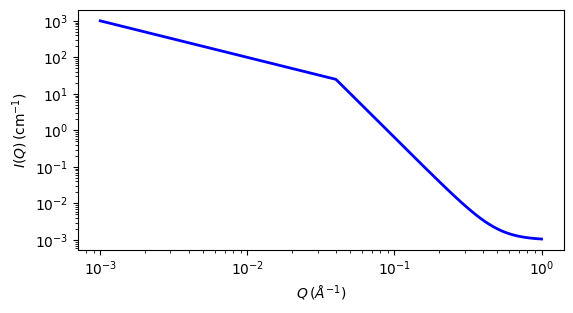two_power_law¶
This model calculates an empirical functional form for SAS data characterized by two power laws.
Parameter |
Description |
Units |
Default value |
|---|---|---|---|
scale |
Scale factor or Volume fraction |
None |
1 |
background |
Source background |
cm-1 |
0.001 |
coefficent_1 |
coefficent A in low Q region |
None |
1 |
crossover |
crossover location |
Å-1 |
0.04 |
power_1 |
power law exponent at low Q |
None |
1 |
power_2 |
power law exponent at high Q |
None |
4 |
The returned value is scaled to units of cm-1 sr-1, absolute scale.
Definition
The scattering intensity \(I(q)\) is calculated as
where \(q_c\) = the location of the crossover from one slope to the other, \(A\) = the scaling coefficient that sets the overall intensity of the lower Q power law region, \(m1\) = power law exponent at low Q, and \(m2\) = power law exponent at high Q. The scaling of the second power law region (coefficient C) is then automatically scaled to match the first by following formula:
Note
Be sure to enter the power law exponents as positive values!
For 2D data the scattering intensity is calculated in the same way as 1D, where the \(q\) vector is defined as

Fig. 127 1D plot corresponding to the default parameters of the model.¶
Source
References
None.
Authorship and Verification
Author: NIST IGOR/DANSE Date: pre 2010
Last Modified by: Wojciech Wpotrzebowski Date: February 18, 2016
Last Reviewed by: Paul Butler Date: March 21, 2016